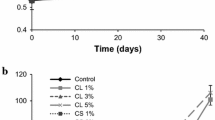Abstract
A new aromatization method for olive oils with saffron aqueous extracts rich in safranal has been developed using liquid–liquid extraction. Four flavoured olive oils were obtained (SO1–SO4). SO1 showed the highest safranal concentration (145.89 mg L−1), followed by SO2 (79.33 mg L−1), SO3 (0.30 mg L−1) and SO4 (0.01 mg L−1). Although flavouring originated a decrease in the quality parameters and the oxidative stability of the oils, even after 7 months of storage, at room and refrigeration temperatures, the oil parameters evaluated were still comparable to those of extra virgin olive oil. Flavored olive oils with less safranal (SO3, SO4) are preferred by consumers.






Similar content being viewed by others
References
Amanpour A, Sonmezdag AS, Kelebek H, Sellia S (2015) GC–MS–olfactometric characterization of the most aroma-active components in a representative aromatic extract from Iranian saffron (Crocus sativus L.). Food Chem 182:251–256
Anzaldúa A (1994) La evaluación sensorial de los alimentos en la teoría y la práctica. Acribia S.A, Zaragoza
Arcoleo G, Indovina MC, Varvara G, Lanza CM, Mazzaglia A (2009) Improving olive oil shelf life with lemon essential oil. Chem Eng Trans 17:849–854
Asensio CM, Nepote V, Grosso NR (2013) Consumers acceptance and quality stability of olive oil flavoured with essential oils of different oregano species. Int J Food Sci Technol 48(11):2417–2428
Ayadi MA, Grati-Kamoun N, Attia H (2009) Physico-chemical change and heat stability of extra virgin olive oils flavoured by selected Tunisian aromatic plants. Food Chem Toxicol 47(10):2613–2619
Baiano A, Terracone C, Gambacorta G, La Notte E (2009) Changes in quality indices, phenolic content and antioxidant activity of flavored olive oils during storage. J Am Oil Chem Soc 86(11):1083–1092
Carmona M, Zalacain A, Alonso GL (2006) The chemical composition of saffron: color, taste and aroma, 1st edn. Bomarzo, Albacete
Carmona M, Zalacain A, Salinas MR, Alonso GL (2007) A new approach to saffron aroma. Crit Rev Food Sci Nutr 47(2):145–159
Dog LW (2006) A reason to season: the therapeutic benefits of spices and culinary herbs. Diet Nutrition 2:446–449
EC (2003) Commision regulation (EC) No 1989/2003 amending Regulation (EEC) No 2568/91 on the characteristics of olive oil and olive–pomace oil and on the relevant methods of analysis. Off J Eur Commun L295:57–77
EEC (1991) Commission Regulation (EEC) No 2568/91 of 11 July 1991 on the characteristics of olive oil and olive-residue oil and on the relevant methods of analysis. Off J Eur Commun L248:1–82
Estruch R, Ros E, Salas-Salvadó J, Covas M-I, Corella D, Arós F, Gómez-Gracia E, Ruiz-Gutiérrez V, Fiol M, Lapetra J, Lamuela-Raventos RM, Serra-Majem L, Pintó X, Basora J, Muñoz MA, Sorlí JV, Martínez JA, Martínez-González MA (2013) Primary prevention of cardiovascular disease with a mediterranean diet. N Engl J Med 368(14):1279–1290
Gambacorta G, Faccia M, Pati S, Lamacchia C, Baiano A, La Notte E (2007) Changes in the chemical and sensorial profile of extra virgin olive oils flavored with herbs and spices during storage. J Food Lipids 14(2):202–215
García-Rodríguez MV, Serrano-Díaz J, Tarantilis PA, López-Córcoles H, Carmona M, Alonso GL (2014) Determination of saffron quality by high performance liquid chromatography. J Agric Food Chem 62(32):8068–8074
Gutiérrez F (1989) Determinación de la estabilidad oxidativa de aceites de oliva vírgenes: comparación entre el método A.O.M. y el método Rancimat. Grasas Aceites 40:1–5
Hinneburg I, Damien Dorman HJ, Hiltunen R (2006) Antioxidant activities of extracts from selected culinary herbs and spices. Food Chem 97(1):122–129
Hosseinzadeh H, Sadeghnia HR (2005) Safranal, a constituent of Crocus sativus (saffron), attenuated cerebral ischemia induced oxidative damage in rat hippocampus. J Pharm Pharm Sci 8(3):394–399
ISO (2003) International Organization for Standarization. Saffron (Crocus sativus L.). Part 1: specification, part 2: test methods (ISO). Geneva
Issaoui M, Flamini G, Hajaij ME, Cioni PL, Hammami M (2011) Oxidative evolution of virgin and flavored olive oils under thermo-oxidation processes. J Am Oil Chem Soc 88(9):1339–1350
Justesen U, Knuthsen P (2001) Composition of flavonoids in fresh herbs and calculation of flavonoid intake by use of herbs in traditional Danish dishes. Food Chem 73(2):245–250
Maggi L, Carmona M, del Campo CP, Kanakis CD, Anastasaki E, Tarantilis PA et al (2009) Worldwide market screening of saffron volatile composition. J Sci Food Agric 89:1950–1954
Maggi L, Sanchez AM, Carmona M, Kanakis CD, Anastasaki E, Tarantilis PA et al (2011) Rapid determination of safranal in the quality control of saffron spice (Crocus sativus L.). Food Chem 127:369–373
Moldão-Martins M, Beirão-da-Costa S, Neves C, Cavaleiro C, Salgueiro L, Luísa Beirão-da-Costa M (2004) Olive oil flavoured by the essential oils of Mentha × piperita and Thymus mastichina L. Food Qual Prefer 15(5):447–452
Ordoudi SA, Cagliani LR, Lalou S, Naziri E, Tsimidou MZ, Consonni R (2015) 1H NMR-based metabolomics of saffron reveals markers for its quality deterioration. Food Res Int 70:1–6
Pardo JE, Sena E, Cuesta M, Granell J, Valiente J, Alvarez-Ortí M (2013) Evaluation of potential and real quality of virgin olive oil from « Campos de Hellín » (Albacete, Spain). J Am Oil Chem Soc 90:851–862
Peryam DR, Girardot NF (1952) Advanced taste-test method. Food Eng 24:58–61
Pitenis N (2012) Production of an olive oil with increased antioxidants properties, enriched with the extraction of saffron (Crocus sativus L.). Patent WO2012114133 A1
Rubió L, Motilva M-J, Macià A, Ramo T, Romero MP (2012) Development of a phenol-enriched olive oil with both its own phenolic compounds and complementary phenols from thyme. J Agric Food Chem 60(12):3105–3112
Samarghandian S, Borji A, Delkhosh MB, Samini F (2013) Safranal treatment improves hyperglycemia, hyperlipidemia and oxidative stress in streptozotocin-induced diabetic rats. J Pharm Pharm Sci 16(2):352–362
Serrano-Díaz J, Sánchez AM, Maggi L, Carmona M, Alonso GL (2011) Synergic effect of water-soluble components on the coloring strength of saffron spice. J Food Compos Anal 24(6):873–879
Serrano-Díaz J, Sánchez AM, Maggi L, Martínez-Tomé M, García-Diz L, Murcia MA, Alonso GL (2012) Increasing the applications of Crocus sativus flowers as natural antioxidants. J Food Sci 77(11):C1162–C1168
Servili M, Esposto S, Fabiani R, Urbani S, Taticchi A, Mariucci F, Montedoro GF (2009) Phenolic compounds in olive oil: antioxidant, health and organoleptic activities according to their chemical structure. Inflammopharmacology 17(2):76–84
Tarantilis PA, Polissiou MG (1997) Isolation and identification of the aroma components from saffron (Crocus sativus). J Agric Food Chem 45(2):459–462
Ulbricht C, Conquer J, Costa D, Hollands W, Iannuzzi C, Isaac R, Jordan JK, Ledesma N, Ostroff C, Serrano JM, Shaffer MD, Varghese M (2011) An evidence-based systematic review of saffron (Crocus sativus) by the Natural Standard Research Collaboration. J Diet Suppl 8(1):58–114
Zalacain A, Ordoudi SA, Blázquez I, Díaz-Plaza EM, Carmona M, Tsimidou MZ, Alonso GL (2005) Screening method for the detection of artificial colours in saffron using derivative UV–Vis spectrometry after precipitation of crocetin. Food Addit Contam 22(7):607–615
Author information
Authors and Affiliations
Corresponding author
Rights and permissions
About this article
Cite this article
Sena-Moreno, E., Alvarez-Ortí, M., Serrano-Díaz, J. et al. Olive oil aromatization with saffron by liquid–liquid extraction. J Food Sci Technol 55, 1093–1103 (2018). https://doi.org/10.1007/s13197-017-3025-6
Revised:
Accepted:
Published:
Issue Date:
DOI: https://doi.org/10.1007/s13197-017-3025-6




